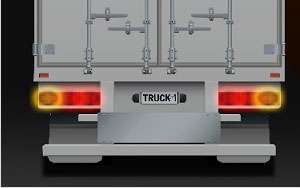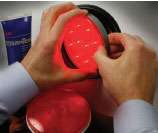Bright Ideas

It’s a fact of life: Bulbs burn out. When those bulbs are on a vehicle, their expiration can create safety concerns and a reason to be stopped by law enforcement en route to a delivery, putting an on-time connection at risk.
It’s a nuisance and a potential expense to your customers. It also can be eliminated by a 50:1 ratio by going to LED lighting.
Depending on the spec, there are no less than a dozen exterior lights on any given Class 8 truck. Tail, clearance, turn and marker lights all illuminate and they are all required to be functional for legal operation.
There’s no warning signal to indicate when one goes out, and a pre-trip inspection is the best insurance your customers have that they are in compliance. But if you are able to upgrade your customers using incandescent lighting to LED lighting with the promise of greater assurance that lights will operate 50 times longer, that’s a huge selling point. When you factor in they require less energy, are more robust and will save money during the life of the vehicle, it should become an “it sells itself” scenario.
“LED lamps may require a higher initial investment, but the reduction in maintenance and downtime makes up the difference quickly,” says Jamie Lindemuth, marketing coordinator for Truck-Lite Co. “The added durability and performance of LED lamps translates to minimal downtime and replacement costs, with a return on investment in less than two years.”
But the adoption of LED lighting is not yet universal, despite the many upsides. Part of the reason may be that customers are simply unaware of those upsides.
LED lamps can bring a return on investment in less than two years.
“If you put on LED lights, they are brighter, more energy efficient, last longer, lower operating costs – all of these things that will help enhance the value of the truck and trailer,” says Everett Seymoure, global manager for TRP Aftermarket Parts. “Those are things you need to tell a potential customer.”
With customers looking at every aspect of their operations to cut expenses, the financial benefits of converting to LEDs is a proposition they will likely want to hear. Not only should the longer life of the component be considered, but also factor in the reduced maintenance requirements for changing out lamps.
“A large percentage of fleets are looking for the lowest maintenance costs during the life of the vehicle and LED lamps certainly can be a factor when considering cost,” says Adam Bean, new product development manager for Phillips Industries.
And the budget benefits don’t stop there. LED lamps require less power so they create less of a drain on the battery and other electrical components.
“Using LEDs reduces the total electrical load on the entire electrical system, thus less stress on electrical-related components, such as batteries and alternators, which equates to longer life for these components,” says Grote’s Page Large, national fleet sales manager.
The lower power draw also pays off when the vehicle is on the road, particularly in this age of greater environmental regulations.
“LEDs draw much less power than incandescent or fluorescent lamps. Because of this, lamps can be used for a longer duration when the vehicle is parked,” says Bean. “With tougher anti-idling laws, a truck driver is looking to gain as much performance from the vehicle without having to restart the engine to power up the batteries. From this aspect, battery power lasts longer and the chance of the tractor needing a jump start is lessened considerably.”
SAFETY SENSE
Two-tenths of a second may not seem like much, but it can make a big difference if you’re travelling toward an object at 65 mph.
Bean points out that LEDs illuminate almost immediately whereas incandescent lamps can take about one-quarter of a second to achieve 90 percent of their brightness. The faster the stop lamp illuminates, the more reaction time a driver behind the truck will have. At 65 mph, this fraction of a second more of reaction time can equate to a full car length of additional stopping distance.
Safety is further enhanced in that LEDs do not burn out, they dim over time. Whereas an incandescent lamp will expire instantly, the demise of an LED lamp will be gradually noticeable, thus facilitating replacement before failure. As Bean points out, “it’s easier to make LEDs part of the PM [preventive maintenance] schedule.”
In addition to longer life, LED lamps are more robust. The very nature of their design eliminates many of the things that can cause an incandescent lamp to fail.
“LEDs, generally speaking, are solid-state devices – no moving parts,” says Seymoure. “With an incandescent bulb, what do you have? You have a filament, you have glass, you have vibrations going on and moisture damage is possible. With LEDs, you don’t really have any of that.”
Adds TRP’s Dave Graham, product director of lighting, “LEDs also come with polycarbonate lenses, which are a very hard, acrylic lens. The diodes are embedded in epoxy so that moisture and corrosion don’t get into the circuit boards.”
Of course, one of the biggest differences between an LED and incandescent lamp is the former is much brighter than the latter, providing the vehicle with greater conspicuity.
As Page points out, “LEDs are also brighter than equivalent (form and function) incandescent lights thus chances are the human eye will see an LED sooner or quicker from a distance than an incandescent.”
INSTALLATION CONSIDERATIONS
The parts cost for retrofitting the exterior of a vehicle to all LEDs can be done for a relatively small investment.
According to Large, “Excluding headlights, a DOT legal and complete LED lighting package for a Class 8 truck costs approximately $350.”
LEDs use the same connections as incandescent lamps so retrofitting is generally a simple matter of swapping one out for the other.
For technicians, working with LED lamps can be safer than with traditional bulbs.
“Because LEDs don’t generate as much heat as incandescent, you don’t have to worry about someone touching a bulb and getting burned,” says Seymoure. “It doesn’t have a filament or tube inside so you don’t have to worry about that breaking and cutting someone, so that’s an added safety factor when changing out bulbs and throwing the bulbs away.”
Experts recommend to always upgrade with a compatible flasher relay when retrofitting a vehicle with LED lamps. Without one, the flash rate of the LED turn signals may be incorrect.
The part is only about $20 and a service technician can install it in less than 15 minutes. It’s about the same level of difficulty as changing a fuse.
While many lamps are interchangeable, for instance the same one can be used at the stop, turn and tail positions, Bean says each lamp has its own unique characteristics that vary by manufacturer. He says, “the look of the lamp or LED count is different. For this reason, especially in an owner-operator environment, people tend to purchase the style or brand of lamp they already have to maintain consistency. It is fairly rare to see a vehicle with different LED patterns from different manufacturers on the same vehicle.”
While retrofitting with LEDs makes good business sense, they also hold an aesthetic appeal, particularly to owner-operators. This makes them good candidates for impulse buys if properly displayed in a parts showroom.
“We typically see more impulse buying from the owner-operator market for their show trucks,” Lindemuth says.
 LED and incandescent lamps use the same connections for ease of installation.
LED and incandescent lamps use the same connections for ease of installation.Most lighting manufacturers work with their distribution network to install displays that show-case the full range of LED products, often powered to light up for full effect.
LED lamp technology is not new, but it continues to prove its value in the marketplace. And when that value is calculated and communicated to customers, it should be an easy sell to get them to upgrade. n
Illuminating Facts
It’s not a glowing comparison when the longevity of LED and incandescent lamps are evaluated side by side.
Light manufacturers say LED lamps outlast incandescent lamps 50-to-1, or 100,000 hours versus about 2,000 hours of operation. To put that into perspective, shown here are the 50 4-inch Grote Economy incandescent lamps that it would it take to replace one Grote Select LED lamp during a typical lifetime of operation. The Grote Select lamp retails for approximately $14 and the Economy model retails for about $3.50. The incandescent stop/tail/turn lamp would cost a customer about $175 in replacement parts versus the $14 cost of installing the LED lamp.






